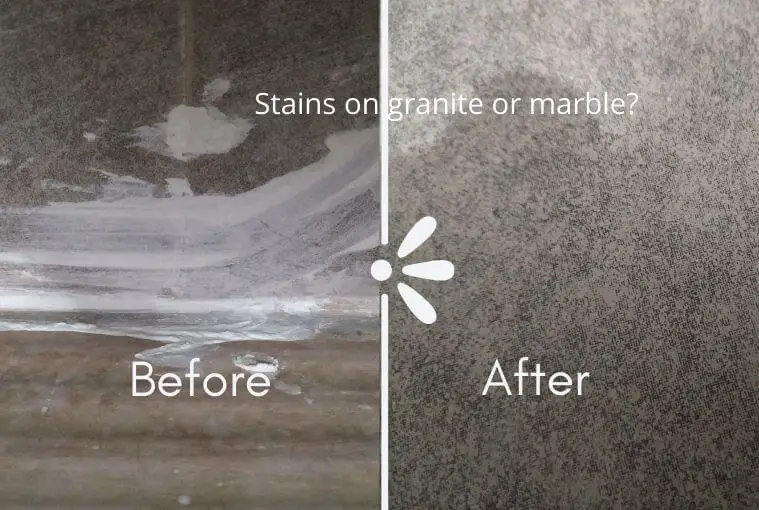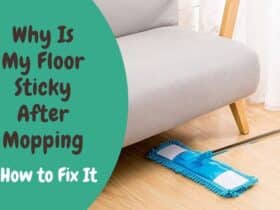A clean peaceful home is what every homemaker wants to offer to her family.
Cleanliness draws positive energy into the house making it a place you want to come back to always. But spills and stains are inevitable, thanks to oil, grease, hard water, and much more.
Stains might be inevitable but with a few magical easy home remedies, you can keep your marble and granite countertops and floors sparkling forever.
Why do the marble and granite stain?
Both granite and marble are porous due to which they absorb liquids that spill on them. However, if the stones are not treated promptly, the liquids can penetrate the stone and cause stains. With proper care, they can survive for several years.
Granite is less porous than marble making it ideal as countertops.
Marble is also softer than granite whose crystalline structure makes it better resistant to abrasion, discoloration, and staining. Granite is the strongest among all-natural stones.
Both marble and granite are mainly composed of silica or similar particles making them very durable and easy to clean.
Types of Stains
- Oil-Based: can be caused by accidental grease, tar, oil, milk, cosmetics, or other oil-based item spills on granite and marble. The oil-based marble or granite stain will darken the stone and can be removed with some effort.
- Food Item or Organic Stains: caused by coffee, tea, fruit, food particles, bird droppings and many more may cause a light brownish or pinkish stain. These stains either on countertops or outside areas can be cleaned very easily.
- Scratches and Dents: marble is more prone to scratches and slight surface scratches can be buffed with dry steel wool. However, deeper scratches on the surface must be repaired and re-polished by professionals, lest you spoil it further.
- Water Spots and Rings: such stains are caused by hard water and can be tackled by using warm water and dry steel wool.
- Metals Stains: caused by metals like iron, copper, and bronze. Rust stains due to iron are orangish to brown and are shaped like the staining object such as bolts, screws, cans, and so on. Stains from copper and bronze appear green or muddy brown when the metal comes in contact with moisture. Such stains require a lot of effort and may not go away completely.
You will have to use granite poultice to get rid of such stains.
- Paint: accidental spilling of paint on marble or granite countertops or floors can become a problem. Latex or acrylic paints will not cause any staining and oil-based paints, putty, caulks may only cause oily stains.
Small amounts of commercial paints can be removed with lacquer thinner or scraped carefully with a razor blade. But heavy paint spills will require help from professionals as it will require paint strippers that you or I cannot handle.
There are other types of stains such as growing algae and moss, ink spills, fire, and smoke damage which can either be cleaned at home or require professional help.
Now we know the types of stains you can encounter, but how to get stains out of granite or marble, let’s see:
Commercial Cleaning Agent to Your Rescue
A stain won’t leave on its own, you have to put in an effort to get rid of it.
You can use a dishwashing liquid (of your choice), preferably a PH-neutral cleaner. Add the cleaning liquid and water in equal ratios and scrub the stain gently. Wipe the area with a cloth and let it dry.
If the stain is still there, now is the time to apply a poultice.
Making and Using Poultice
What is a poultice?
A poultice is an ancient medical technique to cure inflammation, or pain in different parts of the body and heal wounds. It involves making a paste of a powder that heals with liquid, applying on the affected area, and covering it with a cloth or plastic sheet.
Fortunately, this technique works well as a granite stain remover as well. Although stone poultice products are easily available online, the joy of making one yourself is immeasurable.
A basic granite poultice can be made by mixing half a cup baking soda with enough water to create a paste-like consistency similar to sour cream. Note that not all stains can be removed using this poultice.
Here’s how to remove oil from granite countertop using poultice?
- Mix two tablespoon talc powder with enough hydrogen peroxide to make a poultice. The poultice paste must have the consistency of putty.
Talc powder acts as a good absorbent for oily surfaces and hydrogen peroxide loosens stains and removes them.
- Apply the poultice to the stained area, not around it, else the area without the stain can get discolored. The layer of paste must be half an inch thick on the stain.
- Follow it up by covering the area with plastic wrap taping the edges down. The plastic wrap will increase the temperature and moisture easing the stain removal process. Leave the poultice to sit for a day.
- After 24 hours remove the tape and plastic wrap uncovering the paste which will be moist.
- Allow the paste to remain uncovered on the stain until it is completely dry. Depending on the weather this may take a couple of hours to a couple of days to dry out completely. Be patient.
- Once the paste is completely dry scrape away the paste using a scraper or knife. Be careful with the knife to not scratch the surface beyond repair.
- Wipe the remaining paste with a damp cloth and dry it with a clean cloth.
- If the stain remains, repeat steps.
This poultice will effectively remove grease from granite and marble along with oily stains.
Poultice For Porous Countertops
Most stains on countertops can be removed using this poultice.
Ingredients
- Wicking chemical: it will depend on the type of stain. For food stains, you can use hydrogen peroxide, for oils stains a good quality dish detergent, and stains caused due to mold, and fungi try using bleach. Much precaution is needed when you clean with bleach.
- Absorbent base: choose according to your preference from flour, dry clay, or paper towel.
- Tape
- Wax Paper
- Plastic scraper
Directions
- Prepare a thick paste by mixing the wicking chemical with the absorbent base. The choice of absorbent and chemical will be according to the type of stain.
- Apply a thick layer of the poultice onto the stain.
- Cover the poultice with the waxing paper and tape the edges.
- Leave the poultice to sit for 24 hours.
- Once the poultice is dry scrape it off using a plastic scraper.
- Wipe the area with a damp cloth and dry it with a clean towel.
- Repeat the steps if the stain has lightened but is still visible.
Do remember to do a spot test before applying the poultice to the stained area.
Handy Spray To Keep Your Household Surfaces Clean
A damp cloth is not always very effective when cleaning surfaces, hence prepare a spray to clean spills to avoid stains.
Spray Ingredients
- 4 cups of water
- A cup of distilled white vinegar
- 2 teaspoon castile soap (preferably hemp or peppermint oils)
- 1 cup hydrogen peroxide
- 1 ½ tablespoon of tea tree oil, lavender oil, and lemongrass oil.
Mix all the ingredients well in a plastic spray bottle. This mixture can be used on wood, acrylic, marble, and granite surfaces.
Seal The Top
Another tip to keep your countertops sparkling is to add an additional layer of protection to the inherently sturdy stone.
A good quality sealant may have a life expectancy of at least a couple of decades. You either get a professional to seal these highly porous countertop stones or DIY and enjoy a clean countertop for decades.
Use a Doormat
The easiest way to keep marble or granite floorings clean inside your home if you do not prefer carpets is to keep trendy doormats. Several online stores have a huge range of doormats to suit your color and material preferences.
If you like creating yourself, use your old clothes to design a rug for your home, beautifying and keeping it clean at the same time.
Prevention is Always Better Than Cure
Stains can happen within 30 minutes of contact, hence:
- Wipe spills quickly.
- Avoid using abrasive cleaners.
- Use only granite and marble approved cleansers.
- Do not seal your countertops with existing stains or damaged surfaces as sealants won’t restore shine or even out discoloration.
Also, before applying any treatment, do a spot test, and examine the stain carefully. If the stain exists but is lighter than before, the treatment is working. Keep applying till the stain is completely removed.
What Must You Not Use To Clean Granite Or Marble Countertops?
You must avoid applying unconcentrated alcohol or hydrogen peroxide on the countertop for cleaning granite stains. Doing so can cause more damage to the countertop.
Additionally, do not apply other products that are acidic such as lemon juice, ammonia, bleach, and vinegar. These products must be applied only in small amounts.
You must also stay away from abrasive tools like knives for scraping.
It is important to be sure that it is a stain and not damage before trying remedies. Do not try remedies on damaged surfaces, it is best left to professionals.









Leave a Reply
View Comments